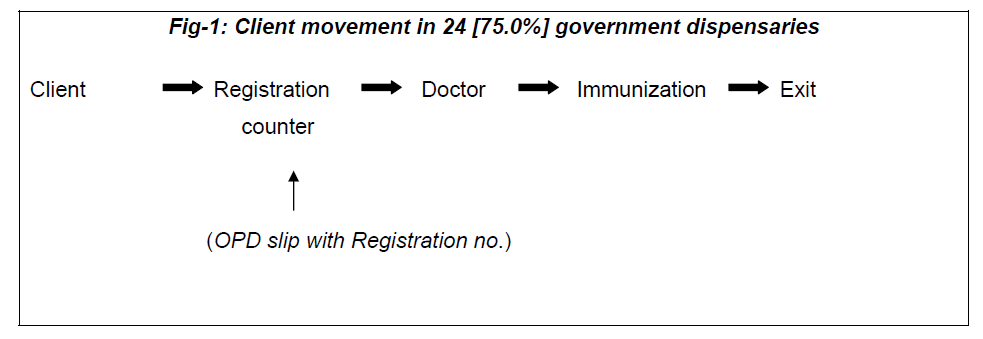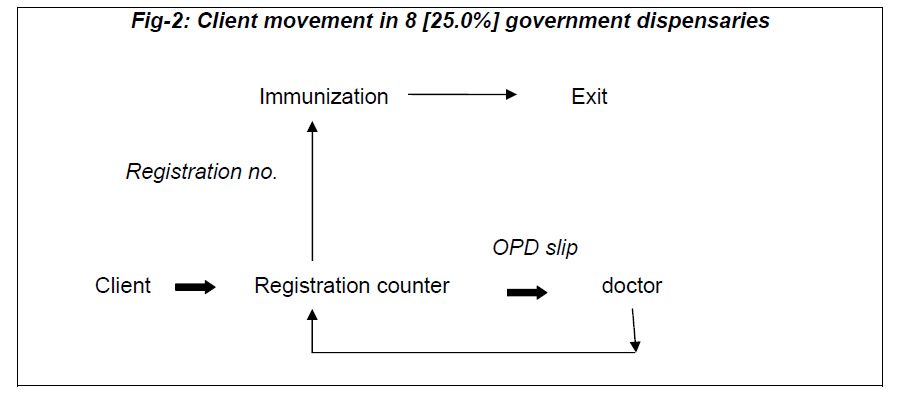- Biomedical Research (2010) Volume 21, Issue 1
Study of client movement availing immunization services in urban government dispensaries
Sandeep Sachdeva1* and Utsuk Datta21National Consultant [BC], Ministry of Health and Family Welfare, Nirman Bhawan, New Delhi, India
2Department of Education and Training, National Institute of Health and Family Welfare [NIHFW], Munirka, New Delhi, India
- Corresponding Author:
- Sandeep Sachdeva
National Consultant [BC]
Ministry of Health and Family Welfare
Nirman Bhawan, New Delhi-110108
India
E-mail: drsandeepsachdeva@gmail.com
Cell phone: +091- 9811329227
Accepted Date: August 24 2009
Abstract
A study was conducted to assess client movement availing immunization services in gov-ernment dispensaries of Delhi, India. Out of 12 municipal zones in Delhi, one was selected randomly and all 32 government dispensaries functional in this zone were covered by a sin-gle investigator during the period Oct 2005- Mar 2006. It was found that client movement and registration procedure was smooth, unidirectional and efficient in 24 [75%] health fa-cilities where as in 8 [25%] it resulted in double contact with registration counter leading to confusion, crisscross movement and delay in receiving desired services with the possibility of attrition and incomplete childhood immunization series.
Keywords
Client movement, immunization, health facilities.
Introduction
In today’s world health care beneficiaries are more sophisticated, empowered and demand quality services in a smooth & efficient manner. Health care organizations are operating in an extremely competitive environment and patient satisfaction has become a key to gaining confidence and maintaining market lead. Client’s satisfaction largely determines their compliance with the treatment & follow up thus resulting in positive outcome.
The fundamental premise has been reiterated time and again that health care delivery should be organized in such a manner that the ‘needs’ of the clients is met in a most efficient and effective way. Still there occurs a gap in understanding the principle and implementing at the service delivery front. From this perspective, an attempt was made to study the client movement availing childhood immunization services in government dispensaries operating in Delhi, India.
Setting
The state of Delhi in India has an area of 1,483 sq. km. and a population of 17.06 million (2008) with 9 districts, 12 municipal zones, 14 blocks and about 400 villages. The State has a population density of 9,340 per sq. km. (as against the national average of 324). Of the total population in Delhi, nearly 53% and 47% seek private & public medical care respectively. On the other side, according to client satisfaction survey, 44% & 21% were satisfied with services received in private & government health facility respectively.1 This survey was suggestive of huge unmet need and dissatisfaction amongst the clients but more-so in government health facilities. With respect to complete childhood immunization upto age-one, National Family Health Survey [NFHS]-I, III, III indicated 58% [1991-92], 70% [1998-99] and 63% [2005-06] coverage in Delhi.
Methodology
Out of 12 municipal zones in Delhi, one [south] was selected randomly. There were 32 dispensaries functional in the south municipal zone and all of them were covered in the present study. Each dispensary provides primary care services from 8:00/9:00 am to 1:00/2:00 pm [IST] six days a week with immunization being provided on the designated one/two days. Each centre caters to about 15-40 children per immunization session with overall daily OPD attendance ranging from 35 to 60. Observation was made regarding movement and registration procedure of the clients [mother/attendant] availing childhood immunization. Discussions were held with the health personnel in the concerned health facilities for understanding and clarification regarding the management information system. The cross-sectional observational study was carried by a single investigator on the immunization days during the period Oct 2005 to Mar 2006 after taking permission from competent authorities.Results
The process of client movement and registration of each client visit was similar & unidirectional in 24 [75.0%] dispensaries (Fig-1) whereas in 8 [25.0%] health facilities, client visit resulted in double contact with the registration counter (Fig-2). At each visit, client would first report to registration counter for getting an OPD slip & then proceed to doctor for screening and advice. These clients would then return back to the registration counter for getting a registration number nd then become eligible to receive the immunization as advised by doctor similar to other dispensaries
Discussion
The performance reporting in these dispensaries are compiled manually in terms of quantity and type of health care services delivered in the register and communicated through monthly reporting format. The procedure of double contact with the registration counter in 8 dispensaries was made for the purpose of Health Management Information System (HMIS). The health personnel manning the registration counter carried out compilation of all performance activity whereas in 24 health facilities reporting was carried out by paramedical worker administering the vaccine. As observed by investigator such procedure of double contact with the registration counter for the same visit resulted in confusion, criss-cross movement, undue harassment and delay in receiving immunization. This could perhaps further lead to lower proportion of children completing age appropriate immunization series because of attrition.
There could be various reasons for low uptake of immunization/Maternal and Child Health (MCH) services amongst community. The various barriers as reported in literature are low perception of need, issue of availability & access of service, socio-economic reasons, lack of knowledge/ awareness, working status of parents, distance from house, inconvenient timing, long waiting time, uncooperative staff behavior and non-availability of logistics or health worker.2-8 While this study does not establishes a link that irksome registration procedure could deter the clients for either initiating or completing the childhood immunization schedule, but necessarily reflect upon the possibility of low immunization uptake in the urban health facilities.
The efficiency and effectiveness of the health system is dependent on one of the pillars of Management Information System (MIS) but at the same time it needs to be ensured that it causes least/no inconvenience to the clients. To conclude, instead of client moving from one room to another for the benefit of health system’s recording and reporting, it would have been more appropriate, if one of the health functionaries was deputed for the same till such time of computerized management information system is implemented in all health facilities.
References
- Programme Implementation Plan [PIP: 2008-09] submitted by Government of NCT of Delhi to Government of India, Ministry of Health and Family Welfare, Nir-man Bhawan, New Delhi.
- Kumari R, Idris MZ, Bhushan V, Khanna A, Agarwal M, Singh SK. Study on patient satisfaction in the government allopathic health facilities of Lucknow district, India. Indian J Community Med 2009; 34: 35-42
- Patro BK, Kumar R, Goswami A, Nongkynrih B, Pan-dav CS, Study Group UG. Community perception and client satisfaction about the primary health care services in an urban resettlement colony of New Delhi. Indian J Community Med 2008; 33: 250-254
- Haldar D, Sarkar AP, Bisoi S, Mondal P. Assessment of client's perception in terms of satisfaction and service utilization in the central government health scheme dispensary at Kolkata. Indian J Community Med 2008;33: 121-123
- Das R, Amir A, Nath P. Utilization and coverage of services by women of Jawan block in Aligarh. IJCM 2001; 26(2): 94-100
- Bajaj J. Knowledge and utilization of maternal and child services in Delhi slums. J of Family Welfare 1999; 45 (1): 44-52.
- Dua A, Sachdev TR, Rasania SK. A study on community awareness on child immunization. IJPH 2000; 44 (4): 134-6.
- Kar M, Reddaiah VP, Kant S. Primary Immunization status of children in slum areas of South Delhi ? The challenge of reaching the urban poor. IJCM 2001; 26 (3): 151-154

